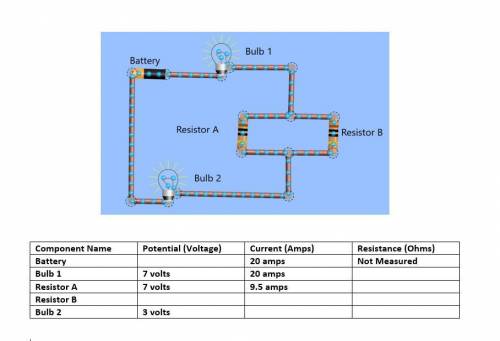Applicable Equations
ΣIin = ΣIout of a junction
V = IR
ΣV = 0 in a loop
You...

Physics, 16.05.2021 19:40 kittykat7315
Applicable Equations
ΣIin = ΣIout of a junction
V = IR
ΣV = 0 in a loop
You will get 0.25 points each for providing the correct numerical answers with their respective units in the table.
You will get one point each for properly identifying how to use Kirchhoff’s first law, Kirchhoff’s second law, and Ohm’s law. To get the full 3 points for this section you must do one of the following:
A: Fill in the table with the correct numerical values of potential, current, or resistance that is missing.
-OR-
B: If you prefer to answer qualitatively or you are not sure of your algebra you may qualitatively explain how to apply Kirchhoff’s 1st and 2nd laws as well as Ohm’s law.
If you can accurately complete the table you do not have to provide any qualitative explanation.


Answers: 1


Other questions on the subject: Physics

Physics, 22.06.2019 06:00, nelsy7610
Suppose water is leaking from a tank through a circular hole of area ah at its bottom. when water leaks through a hole, friction and contraction of the stream near the hole reduce the volume of water leaving the tank per second to cah 2gh , where c (0 < c < 1) is an empirical constant. a tank in the form of a right-circular cone standing on end, vertex down, is leaking water through a circular hole in its bottom. (assume the removed apex of the cone is of negligible height and volume.) (a) suppose the tank is 20 feet high and has radius 8 feet and the circular hole has radius 2 inches. the differential equation governing the height h in feet of water leaking from a tank after t seconds is dh dt = − 5 6h3/2 . if the height of the water is initially 8 feet, how long will it take the tank to empty? (round your answer to two decimal places.)
Answers: 2

Physics, 22.06.2019 07:40, bellapimienta8
Which best describes how fluids change as they travel through different portions of the convection currents? they change to solids at the outer portion of the convection currents. they change to solids at the inner portion of the convection currents. they become more dense at the outer portion of the convection currents. they become more dense at the inner portion of the convection currents
Answers: 2

Physics, 22.06.2019 15:30, championroof
What is a costume plot? why is it important to a film or theater production?
Answers: 3

Physics, 23.06.2019 17:00, isabeltorres5
Conceptualize notice how this problem differs from our previous discussion of gauss's law. the electric field due to point charges was discussed in the previous section. now we are considering the electric field due to a distribution of charge. we found the field for various distributions of charge in the chapter entitled electric fields by integrating over the distribution. this example demonstrates a difference from our discussions in the previous chapter. in this chapter, we find the electric field using law. categorize because the charge is distributed uniformly throughout the sphere, the charge distribution has spherical symmetry and we can apply gauss's law to find the field. analyze note that the following conditions can be used to determine a suitable gaussian surface. condition (1): the value of the electric field can be argued by symmetry to be constant over the portion of the surface. condition (2): the dot product e â· da can be expressed as a simple algebraic product e da because e and da are parallel.
Answers: 3
You know the right answer?
Questions in other subjects:







Business, 20.07.2019 05:40

Business, 20.07.2019 05:40




